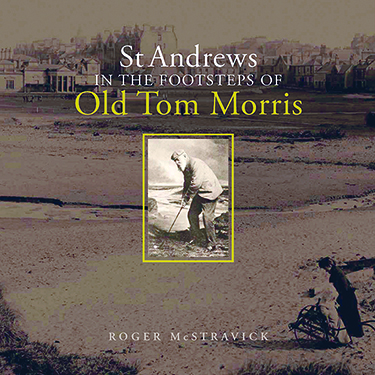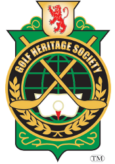
By Roger McStravick
290 pages, www.thegolfbookshop.com, 2015
Foreword from HRH, Prince Andrew, Ouke of York
Three versions —
• The “79 Edition,” leather, £395
• The “1821 Edition,” softback, £60
Quality silk art paper £295
Review by Jim Davis (The Bulletin, September 2015)
The discerning golfer cannot hear the name “Old Tom” and not picture a bewhiskered old gentleman in golfing jacket with long nose spoon at hand. Forever linked with his beloved St Andrews and with golf itself, Old Tom is the gentle lion of our game and its history.
As with the golfer who always wanted a bit more of his game, so it was with author and researcher Roger McStravick who wanted to know more about this revered figure. With his newest book, St Andrews – In the Footsteps of Old Tom Morris, he has planted us squarely in that old gray town and serves as our guide to its leading golfing lights and the streets and buildings they knew so well.
The book’s presentation is immaculate, supervised and created by award winning designer Chic Harper who had at his disposal more than 350 rare photos, paintings, and maps; most from national and private collections and many never before published. Included are rare images of the St Andrews Links taken from the late 1840s onwards. It is a large book, suitable to its subject, measuring 11-by-11.
McStravick has organized his book by specific geographic locations such as Pilmour Links, Golf Place, and The Links, as well as by such institutions as the Royal and Ancient Golf Club and the St Andrews Cathedral, the final home of many of the area’s golfing noteworthies.
We learn of the early days of the golf club makers, their shops and their families. We share in the histories of the Herd family, the Andersons, Forgans, Hutchinson, Condie, and of the great Allan Robertson. We walk the streets with them, particular North Street, so associated with so many great names from Young Tom to Anderson & Gourlay, and the Auchterlonies.
The old buildings may serve as the physical connection, but it is their history that provides the spiritual connection to the revered figures of golfing legend that built, not just clubs and balls, but the foundations of the game we love today.
McStravick’s access to archives of the Royal and Ancient Golf Club of St Andrews, the University of St Andrews and other national and private collections, revealed much new material.
The reader will learn when the land for the 1st hole was actually created, how St Andrews was saved from terminal decline, and why 8 Golf Place is so important. We will read of the birth and growth of ladies golf in St Andrews.
Was Jamie Anderson ruined by drink and ostracised by his family? Why was the Principal’s Nose cut off? Who really was George Bruce – the man behind the Bruce Embankment? Where was the dramatic scene of the death of Tommy Morris’ wife and stillborn child?
There are new studies and biographies on Allan Robertson, Father of The R&A John Whyte-Melville, Hugh Philp, Robert Forgan, Jamie Anderson and many, many more. Family archives from the Tait family include a letter from Queen Victoria’s Private Secretary when Freddie died in 1899.
The various Links are examined in all their rich history and evolution – The Old, The New, The Eden, and the Jubilee. Other landmarks are equally treated from the railway station to Strathtyrum House, and St Andrews Castle and Cathedral. This reader particularly enjoyed learning about the days of the Grand Hotel from its prime as a destination resort, to its checkered history as a student’s dormitory, to its reclamation and restoration by Herb Kohler.
Not a book for the casual reader, In the Footsteps is for the student, nay, the connoisseur, who desires a more intimate association with the immortal legends of St Andrews golf history. Our roots as golfers find their welcome here, in the streets, buildings, and institutions that were the familiar paths, homes, shops, and clubs of those legends; mere mortals then who were plying a trade, earning a living making balls and clubs, laying out new golfing lands, and occasionally arranging a match for a bit of extra cash.
To meet these men, you must walk in their footsteps.
